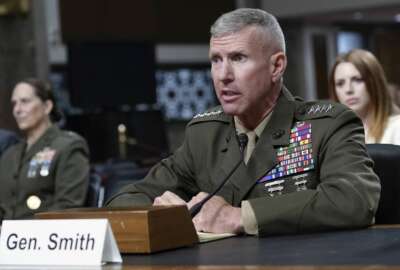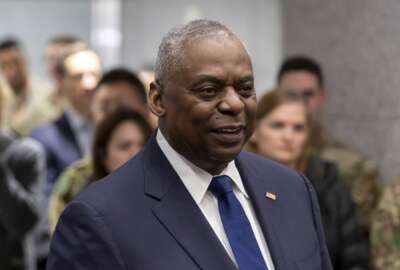Two unlikely agencies team up to promote volunteering
"This is actually a great partnership between our organizations, and it's our first ever partnership," said Joel Spangenberg.
Talk about the odd couple: The Selective Service System and the Peace Corps are joining forces. Under a formal memorandum of understanding, the two agencies have formed a partnership to promote volunteering both here in the U.S. and overseas. The Federal Drive with Tom Temin welcomed Peace Corps director Carol Spahn and Selective Service acting director Joel Spangenberg to discuss more.
Interview transcript:
Tom Temin At first glance, you wouldn’t think that there’s much in common. Joel, your organization tries to get people to volunteer to potentially serve in wartime duty if the need arises. Carol, your organization is the Peace Corps, where you build things and help in the service of peace. So what’s going on here?
Joel Spangenberg Well, this is actually a great partnership between our organizations, and it’s our first ever partnership. And we’re beyond thrilled that we were able to get this done. So actually, about a month ago, we got together to sign an agreement for our agencies to work together. So we have an MOU, and we’re thrilled about it because it’s going to allow us to partner, to elevate people’s awareness of service. And that’s the primary part. So more young people in particular learn about service opportunities both at the Peace Corps and also at Selective Service. And as a second part of this MOU, it will actually allow us, during a time of national emergency, to be able to partner together. We have a national service program ourselves called the Alternative Service Program, and this will allow us, if we have conscientious objectors, to serve in the national interest through the Peace Corps, which we think is a wonderful opportunity to serve the country.
Tom Temin All right. And Carol, what does this bring to the Peace Corps, which tends to have to turn people away, I think, for opportunities?
Carol Spahn Well, there is incredible demand around the world for Peace Corps volunteers, particularly following COVID after a period of long isolation and development setbacks around the world. And so this is a time coming out of that period of isolation, and of really being separated from your global community to elevate this opportunity to serve and to do so in partnership with all kinds of different organizations, including the Selective Service, including AmeriCorps, Teach for America and others, to say there are so many ways to serve and inspire people to look outside themselves, inspire people to take that big leap and do something much bigger than themselves. It’s a really, really important moment in time right now.
Tom Temin And the law requires all young men to register with the Selective Service system, but they don’t do that necessarily in person. So how does the word get out about alternative service program, and how can you let people know that they can bridge over to possible Peace Corps work?
Joel Spangenberg That’s a great question. So there are multiple ways for young men to register. So people are familiar with having to go to the post office and registering that way. But we have modernized, actually our registration is tied to a number of states, I believe at about 46 tied to things like driver’s license issuance. Also, young men can register online as well. And it’s an important distinction. Our alternative service program only is something that would happen during a time of conscription, we’re not in that time, but it’s also important that we maintain fairness and equity at all times. So we look out for the conscientious objector community, because if that time ever came, we would want to make sure that they have important work to do in the national interest at all times. So we see this as a step also kind of going beyond that, where we’re elevating service awareness for young people at all times. After all, in our agencies name selective service system, service is really our middle name. So why not think a little bit more broadly and help others? And we’re excited about this sort of partnership.
Tom Temin I was talking to another organization that’s kind of similar in some ways to Peace Corps, which is AmeriCorps volunteering here in the United States. And one of their issues is more women than men tend to volunteer. Now you’re partnering with Selective Service System, which because of congressional vicissitudes only young men have to register. What’s the gender balance in general for Peace Corps? And could this possibly correct that if there is an imbalance?
Carol Spahn Absolutely. And we do face similar challenges as AmeriCorps. They’re a sister agency to Peace Corps. 70% of our volunteers are female. So we are looking to reach more men, more young men. And we want to make sure that we represent the diversity of America. And it is very challenging to get out into all of the communities, all of the schools, into rural areas, to make sure that people are aware of this opportunity. And I will say that Peace Corps is the most transformational opportunity I have ever seen. Person of any age engage in because it’s so foundationally challenges some of your base perceptions and puts you so far outside your comfort zone that you cannot help but grow and learn and be transformed. So we want that opportunity to be out there for all Americans.
Tom Temin We were speaking with Carol Spahn. She’s director of the Peace Corps and with Joel Spangenberg, acting director of the Selective Service System. And under this memorandum of understanding that you have between the two agencies, what actually happens? How does this work operationally?
Carol Spahn Well, I would say from our part we’re still working through what some of the mechanics might be. The Selective Service clearly has very broad reach. And there are a lot of different ways that we can work together on recruiting strategies, on awareness, and we’re exploring all of those different options.
Tom Temin So you might even have people from the Peace Corps maybe form a subcommittee or something with people from Selective Service and have almost a detail type of system.
Carol Spahn Well, we do have working groups coming together through AmeriCorps and Selective Service. We had a national service summit in June that was hosted by Peace Corps, where we can all come together, share resources, share strategies. There are a lot of things that are evolving right now as we come out of this COVID slump, I will say, and really looking to inspire this next generation.
Joel Spangenberg We’re incredibly inspired by many things right now in service. Carol just highlighted one thing in particular that was really a great moment, I think, for service in this country, which was that Service for America summit. If we go back a little bit, a little over four years ago, the National Commission on Military, National and Public Service issued its report. And this is a bipartisan commission.
Tom Temin We had them on many times when that was operating.
Joel Spangenberg Yeah, they did wonderful work. And I think the timing was tough for them, but their ideas are enduring. And I really am grateful that Carol and the Peace Corps hosted us for this event. And everybody, all the agencies with the Department of Defense, their AmeriCorps, OPM, even we had a representative from the National Security Council. But one thing, we’re all taken away from that report, and also through our effort is that we can work together more to elevate service awareness. And we can really do this for the first time in American history in an integrated way across military national and public service. So we’re really seeing this come together under this Service for America effort. We’re thrilled about this.
Carol Spahn Yeah. And if I can add on to that, 2026 is America’s Sequa Centennial. So it is our 250th birthday. And already there are efforts underway, under that celebration, under a pillar called America Gives to really celebrate service philanthropy, all as a part of American culture, history or can do spirit. And so a lot of this is building up as well to that 2026 celebration.
Tom Temin And in earlier eras, the reach out from these types of federal efforts was television advertising, and it was postcards in Pueblo, Colorado, send a stamp and something will come in the mail on all of this. I think they still have a Pueblo, Colorado booklet center. But today it’s all social media and everything’s different. So do you have a way of reaching out on this theme? And how the heck do you decide where and how to do that?
Joel Spangenberg That’s a great point. So what we really have, it’s selective service is a wonderful channel to young people. As you mentioned already, we engage with America’s young men and we have a well-developed social media and outreach campaign, because we do need to help remind men to register. That’s been a challenge for us in some recent years, but we are using social media in new ways. And we have found that it’s a very effective way to reach them. So sharing more about Peace Corps, about AmeriCorps, I’ll give you another example. We’ve been helping the Department of Defense for over 20 years with they’re recruiting, we are big backers of the all volunteer military to use our channel to help them in our system. So that’s one example. And right now, we’ve actually even have on our website, we have a Web page called Service for America, where if you look at that, if a young man or somebody in that person’s life or it could be somebody else who just stumbles across selective service system, they can find a place to click on it, would take them to the Peace Corps and they can learn about opportunities there, and also with AmeriCorps and with OPM. So we’re leaning forward and we’re looking to see how we can help. And we see ourselves as a hub for service in this country. Let’s use an existing system to help partners. And that’s really that inspiration they keep talking about from that National Commission report.
Tom Temin And volunteers can run into some friction with organizations when actually trying to volunteer. I can think of one in the county where I live in where you help with food insecurity, but the registration to become a volunteer to set foot in their facility is pretty daunting. I gave up a couple of times. I know that a number of years ago, the Peace Corps. Or vastly simplified its application forms and so forth. What’s the latest in reducing friction for those people that you find are compatible and mutually worthwhile endeavor?
Carol Spahn Well, that is always the goal to make it as streamlined as possible. Also, having volunteers go and serve in more than 60 countries around the world with varying access to health care. And other services requires that we have a level of diligence. So it is a constant effort to try to streamline. I did serve in the Peace Corps many, many years ago. I won’t say how many.
Tom Temin I’m guessing it’s 10 or 12.
Carol Spahn Maybe just 10 or 12. But it was a two year process for me at that time with paper and just how the system was set up. That has been significantly reduced, but it is still six to eight months. And it’s a lot to ask when someone is putting their lives together to be able to go and live and serve overseas for two years. So that certainly has been a challenge as people have increasingly been in frictionless environments. But it requires resilience to serve in the Peace Corps and we expect people to be able to to navigate that. And we try to work with them through all of those different processes.
Tom Temin And that’s a good point. Volunteering in the context of a AmeriCorps or Peace Corps is significant, and there are certain missions that they try to serve either locally in the United States or overseas with heavy labor sometimes, and interaction with difficult environments, language barriers. And so I guess you can’t oversell it, at the same time you want to increase interest in it.
Carol Spahn Yes, that’s a challenge. And one of the Peace Corps is most beloved logos slogan, sorry, is it’s the toughest job you’ll ever love. Now, we’ve all been through a very, very tough time here going through COVID. So we want to be real that it will not be easy. We want to be authentic, that it’s not for everyone. But we also want people to know that once you’re there, we will support you along the way. We have your back, we will provide you the training that you need, and you will fail and you will get up and dust yourself off and it will be the most amazing experience you will ever have.
Tom Temin Almost sounds like the Marine Corps, and yet they have no trouble with their recruiting unlike some of the other armed services. Well, getting back to the memorandum and the partnership, what are your metrics for saying, hey, this is working?
Joel Spangenberg A great question. So as I mentioned with our social media, we are looking ways to actually find out if those methods are working. So that’s been an ongoing process for us at Selective Service System. So we’ve thought about things. Are there unique identifiers if somebody clicks on a link that takes them to our registration page, etc. So that’s actually a new area of development. So I think we could find ways to take similar approaches to that. There might be other pilot programs that we can also run where we could get some data, and that’s important that we’re data driven. So we use our resources as effectively as possible.
Tom Temin And does this bring new recruitment channels to the Peace Corps?
Carol Spahn Absolutely. I think that when people are registering for selective service and thinking about their obligations and responsibilities to this country, it’s an opportunity to inspire even more. And I think that’s what we’re hoping to do, is to take what is a mandatory requirement and say, Hey, what are you really all about? What are you made of? And join us in this and become part of something much bigger than yourself.
Copyright © 2025 Federal News Network. All rights reserved. This website is not intended for users located within the European Economic Area.
Tom Temin is host of the Federal Drive and has been providing insight on federal technology and management issues for more than 30 years.
Follow @tteminWFED







